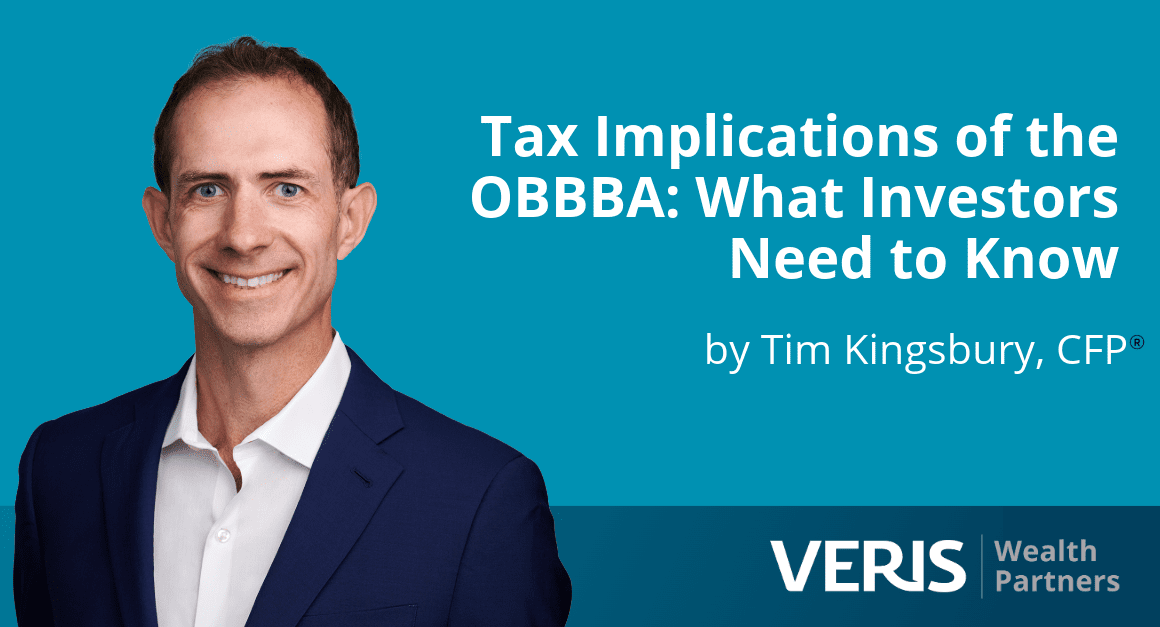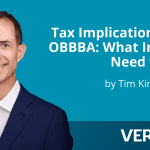The OBBBA of 2025 – What Investors Need to Know & Potential Action Items
By Tim Kingsbury, CFP®
The One Big Beautiful Bill Act (OBBBA), which President Donald Trump signed into law on July 4th, introduces a myriad of tax law changes and makes permanent many tax provisions previously scheduled to sunset or expire in 2025.¹ Note that “permanent” remains a misnomer in the world of tax regulations, as Congress holds the power to make changes in the future.
In this article, we will look at some of the most significant changes the bill will bring for high income earning and high-net-worth taxpayers, as well as suggestions for action steps that readers may wish to consider in light of these shifts.
Tax & Charitable Giving Changes
Some of the tax changes posed by the OBBBA that are most likely to impact high net worth and high-income earners include:
$40k State and Local Tax (SALT) Cap Expansion and Additional Deduction
If your itemized deductions exceed standard deduction amounts, single and married-filing-joint taxpayers’ potential state and local tax (SALT) deduction increases to $40,000 from $10,000. This amount consists of property taxes plus local and state income taxes or state and local sales taxes, but not both.² Property taxes plus local and state income taxes typically comprise the SALT tax deduction, which was introduced to offset federal income taxes. A few things to note:
- The OBBBA makes this change effective from 2025 – 2029, meaning that in 2030 the SALT cap will revert back to $10,000, which sets up another congressional battle later this decade.
- For single and married-filing-joint taxpayers with $500,000 of modified adjusted gross income (MAGI) and up to $600,000 of MAGI, there is a phaseout of the SALT deduction until it reverts all the way back to the prior $10,000 deduction amount for taxpayers with MAGI over $600,000.
- The SALT deduction limit and MAGI phaseout range increase by 1% from 2026 – 2029.
Potential Action Item: For taxpayers who earn close to that phaseout range of income, around $500k, working with a CPA to identify additional deduction opportunities, including charitable giving, can be a powerful strategy to utilize the full new $40,000 SALT deduction.
0.5% of AGI Charitable Deduction Floor
Starting in 2026, a charitable giving tax deduction will be effective only past the amount of 0.5% of adjusted gross income (AGI). For example, the first $1,500 worth of a charitable contribution does not receive a tax deduction for a married couple filing jointly with $300,000 of AGI.
Potential Action Item: This change will create an opportunity to accelerate charitable giving in 2025, for those already planning to give to charity over the next few years, especially if in the top marginal fed tax bracket. Consult with your CPA to determine if and how you may want to respond to this change.
New Charitable Deduction for Non-Itemizers
After 2017’s Tax Cuts and Jobs Act (TCJA) doubled the standard deduction amount, charitable giving decreased by about $20 billion annually.³ In tax year 2020 (filed in 2021), about 90 percent of tax filers claimed the standard deduction, compared with about 70 percent in 2017.⁴
A permanent change set to begin in 2026 is that single taxpayers will be allowed to deduct up to $1,000 of charitable contributions, and those that are married-filing-jointly may deduct up to $2,000. These new deductions:
- Are not subject to the 0.5% of AGI Charitable Deduction Floor.
- Do not apply for contributions to Donor Advised Funds (DAFs), non-operating private foundations and are not indexed for inflation.
- Are a throwback to the CARES Act of 2020, which created a temporary two-year non-itemizer charitable deduction of $300 for single taxpayers, and $600 for those married-filing-jointly. (For more information, see line 10b of the 2020 form 1040 or line 12b of the 2021 form 1040).
Potential Action Item: inform younger generations potentially and other standard deduction takers.
Top 37% Bracket Taxpayers Subject to 35% Itemized Deductions
For high-income taxpayers, the tax benefits of itemized charitable deductions are now capped at 35%, if they are in the 37% marginal tax bracket. For example, filers donating $1,000 would receive a $350 deduction instead of the current $370.⁵ This change begins 2026 and is permanent.
Potential Action Item: This change creates an opportunity for some taxpayers in the highest 37% tax bracket to accelerate deductions in the year 2025.
Additional Deduction for Tax-Payers 65 years and Older
Veiled as “no tax on Social Security,” the OBBBA, passed as reconciliation legislation, cannot amend the Social Security program.⁶ Some folks will indeed continue to pay taxes on Social Security benefits, despite a confusing email shared by the SSA.
- Begins 2025 through 2028, ceasing in 2029
- Additional deduction of $6,000 single, $12,000 married-filing-jointly.
- Phaseout begins at $75,000 MAGI single, fully phased out at $150,000 single filers and $250,000 for married-filing-jointly.
Additional Qualified Small Business Stock Sale Exclusions
The Qualified Small Business Stock tax exclusion (also known as Section 1202 stock after the relevant section of IRS Code) was first introduced in 1993 to encourage investments in certain types of small businesses and startups registered as C Corporations in the United States. Under this law, individual taxpayers have been able to use this exclusion to avoid paying some or all of the capital gains resulting from the sale of Section 1202 stock, subject to certain considerations. Eligible companies are typically involved in technology, life sciences, advanced manufacturing, and wholesale. Ineligible sectors include hospitality, financials, farming, personal services and mining.
The OBBBA made some new changes to IRS Code Section 1202 that will impact taxpayers who purchase eligible stock after July 4, 2025:
- The new minimum hold is three years (instead of five years as dictated by the law before the passage of the OBBBA.)
- Now, taxpayers who sell Qualified Small Business Stock after the required minimum of three years are eligible to exclude 50% of their capital gain; after four years they are eligible to exclude 75%; and after five years, 100% of the capital gain up to the cap (see the point below).
- The OBBBA increased the cap / maximum tax benefit to greater of $15M or 10x the share cost basis. Prior to the passage of the new law, the cap was $10M and 10x cost.
- In previous years, eligible small businesses and C Corps had to have no more than $50 million in gross assets. The new law increased that limit to $75 million in gross assets before and immediately after equity issuance.
Potential action item: Talk to your Advisor if you are considering purchasing eligible stock in the hopes of taking advantage of this expanded tax exclusion, and keep in mind that an estimated 90% of startups fail.⁷
Finance professionals tend to agree that diversification is important and that most investors can benefit from conversations with experts, including financial advisors and tax consultants, before making investment decisions. At Veris, we believe that the fund structure provides diversification for high growth, early stage investing and we offer our clients multiple Venture Capital Fund investment opportunities across climate technology, recidivism reduction, small businesses from overlooked founders.
The OBBBA made Several Provisions Permanent that Were Scheduled to Sunset in 2026
Several tax changes implemented in previous years were scheduled to automatically terminate in 2026, but the passage of the OBBBA means that several of these are permanent and will not sunset including:
- Tax brackets and elevated standard deduction levels set in the 2017 Tax Cuts & Jobs Act (TCJA) will remain in effect.⁸
- Gift and estate tax levels will now increase from $13.99M per person to $15MM per person. In 2019, approximately 2,600 taxable estates were filed in the United States.⁹
- Qualified Business Income (QBI) deduction, allows owners of certain pass-through businesses, such as sole proprietorships, partnerships, S corporations and some trusts, to deduct up to 20% of their qualified business income, effectively reducing their taxable income and the marginal rate applied to it.¹⁰
As always, consult with your CPA or tax professional, as many factors, including your age, income-level, state of residence, charitable giving plans, mortgage interest, current itemized deduction amounts, and others can influence tax planning.
Other Impacts of the OBBA
In this post, we have only explored some of the tax related changes that will stem from this new law. Besides tax updates, OBBBA also contains multiple reductions to environmental initiatives and reduces essential social safety net programs, including Medicaid and SNAP. We aim to cover the potential impacts of those shifts in more detail in the future.
About the Author
Tim Kingsbury is a Veris Partner, Advisor, and a CERTIFIED FINANCIAL PLANNER® professional. Based in the firm’s New York office, Tim is focused on helping clients meet their financial and impact goals.
Sources
1. https://www.congress.gov/bill/119th-congress/house-bill/1/text
2. https://tax.thomsonreuters.com/en/glossary/salt-deduction
3. https://www.nber.org/system/files/working_papers/w32737/w32737.pdf
4. https://taxpolicycenter.org/briefing-book/what-standard-deduction
5. www.fidelitycharitable.org/articles/obbb-tax-reform.html
6. www.congress.gov/crs-product/R48444
7. www.goingvc.com/post/surviving-the-startup-gauntlet-lessons-in-failure-and-success
8. www.usbank.com/wealth-management/financial-perspectives/financial-planning/the-real-impact-of-the-tax-cuts-and-jobs-act.html#
Disclaimer
The information contained herein is provided for informational purposes only and should not be construed as the provision of personalized investment, legal, or tax advice, or an offer to sell or the solicitation of any offer to buy any securities. Rather, the contents including, without limitation, any forecasts and projections, simply reflect the opinions and views of the authors. All expressions of opinion reflect the judgment of the authors as of the date of publication and are subject to change without notice. There is no guarantee that the views and opinions expressed herein will come to pass. Additionally, this document contains information derived from third party sources. Although we believe these third–party sources to be reliable, we make no representations as to the accuracy or completeness of any information derived from such third-party sources and take no responsibility, therefore. Investing involves risk, including the potential loss of all amounts invested. The information contained in this document also contains certain forward-looking statements, often characterized by words such as “believes,” “anticipates,” “could,” “plans,” “expects,” “projects,” and other similar words that indicate future possibilities. Due to known and unknown risks, other uncertainties and factors, actual results may differ materially from the expectations portrayed in such forward-looking statements.





